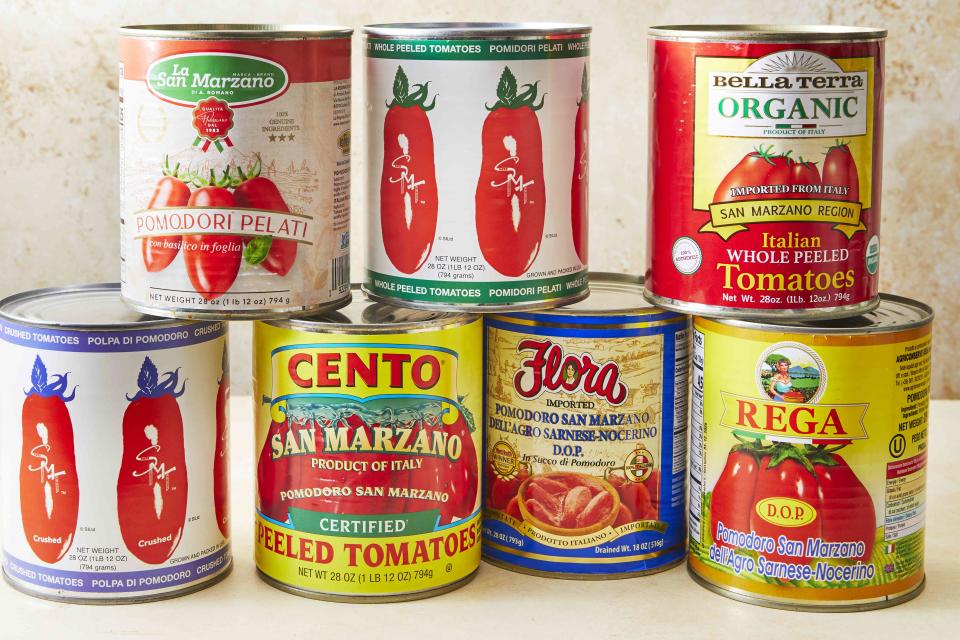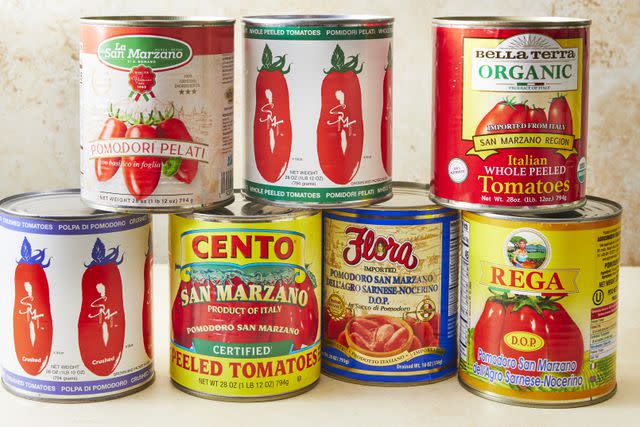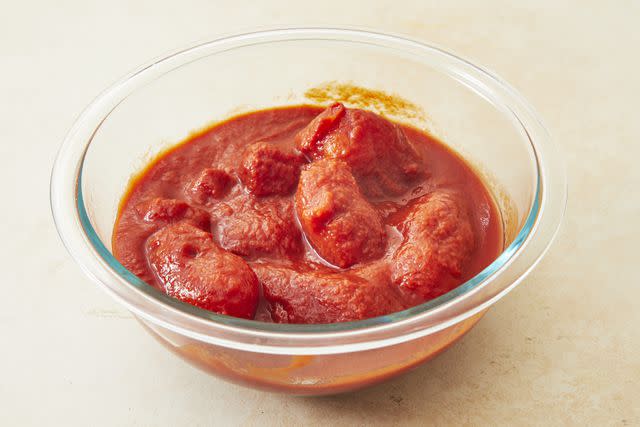What's So Special About San Marzano Tomatoes?
Are these canned Italian tomatoes worth the hype (and the hefty price tag)?

Caitlin Bensel
Canned tomatoes are one of the undisputed M.V.P.s of the kitchen pantry. Ask any chef what ingredients they always keep on hand, and a humble can of tomatoes is bound to be on their list. After all, even if you’ve got nothing more than some dried pasta, a single can of tomatoes, salt, and pepper sitting on your pantry shelves, you can still pull together a comforting homemade dinner with minimal effort.
Plus, tomatoes are so incredibly versatile, they’re the star ingredient in an endless array of recipes, from classics like tomato-basil soup and Bolognese sauce, to gumbo, okra with tomatoes, and other timeless Southern favorites.
But not all tomatoes are created—or priced—equally. We've all probably been confused while surveying the massive selection of canned tomatoes at the local grocery store, wondering what the difference is between the standard cans of tomatoes marked $1.99, versus the tins labeled San Marzano that are usually priced at $5 and up. (Often way up, as much as $10 per can.)
What’s so special about San Marzano tomatoes? And at more than double the price or more, are they really worth the extra money?

Caitlin Bensel
What Are San Marzano Tomatoes?
Named for the Italian town of San Marzano sul Sarno, where the fruit was first cultivated, this tomato variety has historically been grown in a particular region of Italy, Sarnese Nocerino. The region, in the Campania region of sunny southern Italy, sits between Naples and Salerno.
What Makes San Marzanos So Special?
Meaty and oval in shape, these plum tomatoes (aka Roma tomatoes) have low water and seed contents, and are longer and thinner than other types of plum tomatoes. That’s why they’ve become the gold standard for chefs and home cooks alike for making pasta and pizza sauces, and for using as the base for soups and stews.
And because “true” San Marzanos (more on that later) are grown in Sarnese-Nocerino, near Mount Vesuvius, the soil is credited with giving the fruit cultivated there a distinctive sweetness, low acidity, and concentrated tomato flavor. Just as a wine’s unique characteristics are a direct result of the terroir in which its grapes were grown, the distinctive tastes and textures of this tomato are products of its famed volcanic landscape.
Can San Marzano Tomatoes Be Grown in the U.S.?
While true San Marzanos can only come from the Agro Sarnese-Nocerino region of Italy, the same variety of tomato can be grown elsewhere—including the U.S.A. In recent years, more and more American brands have begun producing the crop domestically, particularly in California.
So how are Italian San Marzanos different from those grown in the United States? The results vary by producer, of course. But generally, the ones hailing from Italy tend to be sweeter and richer than their domestic counterparts, which are usually a little more acidic and more heavily salted.

Caitlin Bensel
Why Are San Marzano Tomatoes So Expensive?
Because true San Marzanos are so prized, they have to be imported from Italy, and the sunny, volcanic region in which they’re grown is relatively small, there is more demand for them than other types of canned tomatoes. So the price tags match.
While you can sometimes find true San Marzanos priced as low as $5, $10 per can is not uncommon. So if you see them on sale, it’s smart to stock up.
Are San Marzano Tomatoes Worth The Price?
It depends on your personal taste, but most experts agree that the sweeter and richer flavor of true San Marzanos make them worth the higher cost when compared to conventional canned tomatoes (or even San Marzano tomatoes that are grown in the U.S., Mexico, or anywhere else outside of the true D.O.C.),
But that doesn’t mean you have to use the pricier options for everything. You may want to save them for recipes where the flavor can really shine, like a simple pomodoro sauce or tomato soup.
For other dishes that call for tomatoes—say a pot of chili with beef, beans, veggies, and loads of spices—chances are you wouldn’t be able to tell the difference between the pre-diced, $1.99 cans of tomatoes and the more expensive options anyway.
If you’re a fan of the San Marzano variety but aren’t keen to spend the extra money—and you have a green thumb and a sunny patch of soil—you may even want to consider growing your own. The days of needing an Italian Nonna who saved her heirloom tomato seeds for you are over, since nowadays you can find San Marzano seed packets and plant starts at garden and grocery stores.
Where To Buy San Marzano Tomatoes
Luckily, these days it’s pretty easy to find San Marzanos from Italy on most grocer’s shelves—although many stores may just carry one brand. For a larger imported and domestic selection, you’re best off visiting an Italian market, or upscale or specialty grocer.
How To Make Sure You're Buying Authentic San Marzano Tomatoes
Just like Parmigiano-Reggiano and prosciutto, true San Marzano tomatoes are tightly regulated by the Italian government. But since San Marzano is a variety of tomatoes that can be grown anywhere around the world, in addition to an actual place in Italy where they were originally cultivated, seeing the words “San Marzano” on a label doesn’t mean they were grown in their namesake region in Italy.
If certified authentic, cans are given an official Denominazione d'Origine Protetta (D.O.P.) label, which translates to protected designation of origin. But unfortunately, there are lots of fakes out there, which further complicates the situation. Because of a lack of regulation is the U.S. and widespread fakery, seeing a D.O.P. seal on a label is not enough on its own to guarantee authenticity. Here are the other things to look for to ensure that if you spend the money for San Marzanos, you’re getting the real deal.
Look for a Consorzio San Marzano number stamped on the bottom of the can.
Check for the words Pomodoro San Marzano dell’Agro Sarnese Nocerino.
Make sure the tomatoes are in cans, and are either sold in whole form, or halved. If they’re sold diced, puréed, or in paste form, they’re not authentic.
10 Great Recipes To Make With San Marzano Tomatoes
Now that you're ready to cook with these stellar tomatoes, start with one of these favorite recipes:
For more Southern Living news, make sure to sign up for our newsletter!
Read the original article on Southern Living.

